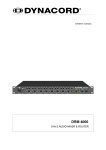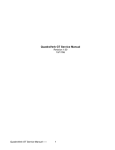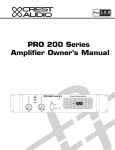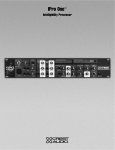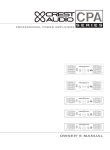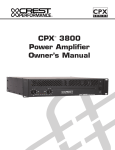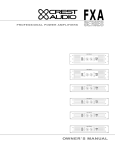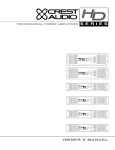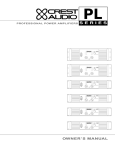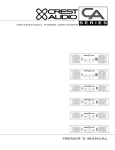Download Crest Audio CPM 2462 - S Specifications
Transcript
CPM™ 2462 Operations Manual Operating Guide For more information on other great Crest products, go to your local Crest dealer or online at www.crestaudio.com. Intended to alert the user to the presence of uninsulated “dangerous voltage” within the product’s enclosure that may be of sufficient magnitude to constitute a risk of electric shock to persons. Intended to alert the user of the presence of important operating and maintenance (servicing) instructions in the literature accompanying the product. CAUTION: Risk of electrical shock — DO NOT OPEN! CAUTION: To reduce the risk of electric shock, do not remove cover. No user serviceable parts inside. Refer servicing to qualified service personnel. WARNING: To prevent electrical shock or fire hazard, do not expose this appliance to rain or moisture. Before using this appliance, read the operating guide for further warnings. Este símbolo tiene el propósito, de alertar al usuario de la presencia de “(voltaje) peligroso” sin aislamiento dentro de la caja del producto y que puede tener una magnitud suficiente como para constituir riesgo de descarga eléctrica. Este símbolo tiene el propósito de alertar al usario de la presencia de instruccones importantes sobre la operación y mantenimiento en la información que viene con el producto. PRECAUCION: Riesgo de descarga eléctrica ¡NO ABRIR! PRECAUCION: Para disminuír el riesgo de descarga eléctrica, no abra la cubierta. No hay piezas útiles dentro. Deje todo mantenimiento en manos del personal técnico cualificado. ADVERTENCIA: Para evitar descargas eléctricas o peligro de incendio, no deje expuesto a la lluvia o humedad este aparato Antes de usar este aparato, Iea más advertencias en la guía de operación. Ce symbole est utilisé dans ce manuel pour indiquer à l’utilisateur la présence d’une tension dangereuse pouvant être d’amplitude suffisante pour constituer un risque de choc électrique. Ce symbole est utilisé dans ce manuel pour indiquer à l’utilisateur qu’il ou qu’elle trouvera d’importantes instructions concernant l’utilisation et l’entretien de l’appareil dans le paragraphe signalé. ATTENTION: Risques de choc électrique — NE PAS OUVRIR! ATTENTION: Afin de réduire le risque de choc électrique, ne pas enlever le couvercle. Il ne se trouve à l’intérieur aucune pièce pouvant être reparée par l’utilisateur. Confiez I’entretien et la réparation de l’appareil à un réparateur Peavey agréé. AVERTISSEMENT: Afin de prévenir les risques de décharge électrique ou de feu, n’exposez pas cet appareil à la pluie ou à l’humidité. Avant d’utiliser cet appareil, lisez attentivement les avertissements supplémentaires de ce manuel. Dieses Symbol soll den Anwender vor unisolierten gefährlichen Spannungen innerhalb des Gehäuses warnen, die von Ausreichender Stärke sind, um einen elektrischen Schlag verursachen zu können. Dieses Symbol soll den Benutzer auf wichtige Instruktionen in der Bedienungsanleitung aufmerksam machen, die Handhabung und Wartung des Produkts betreffen. VORSICHT: Risiko — Elektrischer Schlag! Nicht öffnen! VORSICHT: Um das Risiko eines elektrischen Schlages zu vermeiden, nicht die Abdeckung enfernen. Es befinden sich keine Teile darin, die vom Anwender repariert werden könnten. Reparaturen nur von qualifiziertem Fachpersonal durchführen lassen. ACHTUNG: Um einen elektrischen Schlag oder Feuergefahr zu vermeiden, sollte dieses Gerät nicht dem Regen oder Feuchtigkeit ausgesetzt werden. Vor Inbetriebnahme unbedingt die Bedienungsanleitung lesen. 2 IMPORTANT SAFETY INSTRUCTIONS WARNING: When using electrical products, basic cautions should always be followed, including the following: 1. 2. 3. 4. 5. 6. 7. 8. 9. 10. 11. 12. 13. 14. 15. 16. 17. 18. Read these instructions. Keep these instructions. Heed all warnings. Follow all instructions. Do not use this apparatus near water. Clean only with a dry cloth. Do not block any of the ventilation openings. Install in accordance with manufacturer’s instructions. Do not install near any heat sources such as radiators, heat registers, stoves or other apparatus (including amplifiers) that produce heat. Do not defeat the safety purpose of the polarized or grounding-type plug. A polarized plug has two blades with one wider than the other. A grounding type plug has two blades and a third grounding plug. The wide blade or third prong is provided for your safety. If the provided plug does not fit into your outlet, consult an electrician for replacement of the obsolete outlet. Protect the power cord from being walked on or pinched, particularly at plugs, convenience receptacles, and the point they exit from the apparatus. Note for UK only: If the colors of the wires in the mains lead of this unit do not correspond with the terminals in your plug‚ proceed as follows: a) The wire that is colored green and yellow must be connected to the terminal that is marked by the letter E‚ the earth symbol‚ colored green or colored green and yellow. b) The wire that is colored blue must be connected to the terminal that is marked with the letter N or the color black. c) The wire that is colored brown must be connected to the terminal that is marked with the letter L or the color red. Only use attachments/accessories provided by the manufacturer. Use only with a cart, stand, tripod, bracket, or table specified by the manufacturer, or sold with the apparatus. When a cart is used, use caution when moving the cart/apparatus combination to avoid injury from tip-over. Unplug this apparatus during lightning storms or when unused for long periods of time. Refer all servicing to qualified service personnel. Servicing is required when the apparatus has been damaged in any way, such as power-supply cord or plug is damaged, liquid has been spilled or objects have fallen into the apparatus, the apparatus has been exposed to rain or moisture, does not operate normally, or has been dropped. Never break off the ground pin. Write for our free booklet “Shock Hazard and Grounding.” Connect only to a power supply of the type marked on the unit adjacent to the power supply cord. If this product is to be mounted in an equipment rack, rear support should be provided. Exposure to extremely high noise levels may cause a permanent hearing loss. Individuals vary considerably in susceptibility to noise-induced hearing loss, but nearly everyone will lose some hearing if exposed to sufficiently intense noise for a sufficient time. The U.S. Government’s Occupational Safety and Health Administration (OSHA) has specified the following permissible noise level exposures: Duration Per Day In Hours 8 6 4 3 2 1 1⁄2 1 1 ⁄2 1 ⁄4 or less Sound Level dBA, Slow Response 90 92 95 97 100 102 105 110 115 According to OSHA, any exposure in excess of the above permissible limits could result in some hearing loss. Ear plugs or protectors to the ear canals or over the ears must be worn when operating this amplification system in order to prevent a permanent hearing loss, if exposure is in excess of the limits as set forth above. To ensure against potentially dangerous exposure to high sound pressure levels, it is recommended that all persons exposed to equipment capable of producing high sound pressure levels such as this amplification system be protected by hearing protectors while this unit is in operation. SAVE THESE INSTRUCTIONS! 3 ENGLISH CPM™2462 Rack-Mountable Recording and Sound Reinforcement Mixer II. INTRODUCTION Thank you for purchasing the Crest Performance CPM™2462. The CPM 2462 was design to not only provide maximum versatility and performance for live sound applications, but also to excel when used for recording. To begin, let’s identify these features. * * * * * * * * * * * * * * * * * * * * * * * * Sixteen input channels with XLR mic inputs EQ, pan, aux and group assign controls Eight additional stereo line inputs (17-24) Four different types of input channel configurations for outstanding versatility Universal chassis design allowing rackmount or desktop placement Very-low-noise mic inputs (XLR) with gain trim on all input channels Smooth, 60 mm fader on each channel and Groups 1-4 Phantom power with separate defeat switches for Channels 1-2 and 3-16 Channels 1-8 optimized for 8-track recording (direct output) Insert (in/out) jacks on Channels 1-8 Six aux outputs (2 balanced XLR) Four mono subgroups (1 through 4) One stereo subgroup pair (5 and 6) Phase and pad switches on (1 and 2) Mute switch, clip LED and signal present LED on all input channels Switchable low cut filter on Channels 3-8 Smooth, 60 mm left and right master faders PFL on all input channels and subgroups Stereo headphone and control room outputs Balanced mono output (XLR) with separate level control Balanced stereo L/R output (XLR) Unbalanced stereo L/R output (1/4") Left and right master inserts (1/4") Stereo tape in (1/4" or RCA) and tape out (RCA) jacks Stereo control room outputs (1/4") As you can see, this mixer is packed with features. Obviously, we can only begin to describe the infinite hookup configurations and applications of which the CPM 2462 is capable. We will, however, explain each feature and suggest some common uses as we go along. As you use the CPM 2462 always keep in mind that the capabilities of this mixer are mostly limited to the imagination. Now, let’s talk a bit about how this manual is set up and the format you can expect to encounter on the following pages. 4 Since we are dealing with one serious mixer, the format for this guide will be laid out in the following order for simplicity: I. II. III. IV. V. VI. VII. VIII. IX. X. Table of Contents Introduction (You’re reading it now.) Break It Down Power Rear Panel INs and OUTs Input Channels Master Control Section Block Diagram of Signal Flow Recommended Hookup Diagrams Specifications and Warranty Each section begins with a small statement describing what the section is about and what you should expect to learn from its content. Beginning in Section IV you will find descriptions of the numbered features as well as a diagram showing the features’ physical location on your CPM 2462. Simply match the number of the description to the number on the associated diagram to help you locate it. It is important that you carefully read this guide in its entirety. Pay special attention to the notes and cautions throughout. If possible, keep this manual with your unit to use as reference when needed. We are certain your CPM 2462 will provide you with a pleasurable mixing experience. III. BREAK IT DOWN Before we jump right in, let’s break the CPM 2462 down into smaller units so we can observe them individually. It’s good that you get an understanding of these units before we begin hooking up external equipment. This is a basic explanation of signal flow described in the order at which a signal progresses through each section of the CPM 2462. BUSES Buses are the paths at which your CPM 2462 routes signal throughout its circuitry. Viewing the CPM 2462 Block Diagram on page 20 the buses can be easily identified. Towards the center of the drawing you will see 3 groups of vertical lines with black dots throughout. These are the buses of your CPM 2462. There are essentially 16 buses in which audio signal is passed throughout the CPM 2462. These busses include: Main(L/R), Groups1-6, Aux 1-6 and PFL. INPUT CHANNELS From a signal flow standpoint, it all begins at the channel input stage. The following block diagram shows the topology and basic signal flow of the Input Channels 1 and 2. These two channels have special features and differ from Channels 3-8. 5 Input Channel Reading the diagram from left to right (standard signal flow) you’ll find: a mic input, line input, input pad switch, polarity switch and gain control. From there the signal passes through the insert jack and through the low, mid and high EQ’s. The mid EQ center frequency is adjustable from 40 Hz to 1.2 kHz. The signal for the PFL is taken at this point in the signal chain when the PFL switch is selected for the channel. The signal also continues on to the fader, mute switch, direct out and pan controls. Finally, the signal is sent to the various buses as determined by the assign switches. Channels 1 and 2 can send signal to the following buses: Main(L/R), Groups 1-4, Aux 1-6, and PFL. Channels 3-8 are identical to Channels 1 and 2 with the following exceptions: the addition of the low cut filter (switchable) and the deletion of the pad and polarity switches. If you are mixing a device that may need a switchable pad and/or polarity, such as a bass drum, it is recommended to place them on Channels 1 and 2. Also, the mid EQ center frequency is adjustable from 100 Hz to 3 kHz. The block diagram below is typical of Channels 3-8 and reflects the differences mentioned above. Channels 3-8 can send signal to the following buses: Main(L/R), Groups 1-4, Aux 1-6, and PFL/Solo. Channels 9-16 are designed to accommodate stereo line inputs. These channels eliminate the tape in, tape input select switch, mid-sweep control of the EQ, direct out and insert jacks. Added to Channels 9-16 are a line input select switch, separate line and mic level controls and a stereo pair of 1/4" input jacks. The block diagram below is typical of Channels 9-14. Channels 9-14 can send signal to the following buses: Main(L/R), Groups 1-6, Aux 1-6, and PFL. 6 Channels 9-16 and 17-24 co-exist in on the CPM 2462. Channels 9-14 are mono mic input channels similar to channels 2-8 but with a fixed frequency mid EQ control and without the direct out and insert. However, occupying the same space are stereo line inputs 17-22. A switch on each of these channels determines whether these channels work independently or whether the mic input is muted and the line inputs are routed (mono) through the full featured channel strips 9-14. The line input channels have their own subgroup (group 5-6) that can in turn be routed to the other subgroups or to L/R. Channels 15-16 and 23-24 are nearly identical to their next door neighbors except that channels 15 and 16 are full stereo channels. When stereo line channels 23 or 24 are routed through 15 or 16, the stereo signal is maintained. In all of the stereo line channels 17-24, the rotary line level control is used as the mix control when assigned to group 5-6 or as an input trim control when routed through channels 9-16. The diagrams showing these channels help show how this routine works. NOTE: These additional stereo line input add tremendous versatility to the CPM 2462 by providing eight stereo inputs in addition to the 16 mic inputs. MIXES When we speak of the various mixes on the CPM 2462 we are basically speaking of the resultant signals from the various buses found at the CPM 2462 outputs. Let’s take a look at the individual output sections. Main Stereo L/R and Mono Outputs The first and most common section is the master L/R/Mono output section. In this section the CPM 2462 provides separate Left and Right outputs (both balanced XLR and unbalanced 1/4"). Each signal goes through a final pre-fader insert jack to allow for the placement of master effects in the master L/R signal chain. In addition, the Left and Right signals are also mixed (L+R) to create a balanced (XLR) Mono signal. All three outputs are controlled by the master Left and Right faders. The Mono output is also controlled by its own level control, the Mono Out Level. Use this control to adjust the level of the Mono Out and use the master Left and Right faders to adjust the balance as desired. The following block diagram shows the master L/R/Mono output section. 7 GROUPS 1-4 OUTPUTS The next mix is the Group mix. Groups 1-4 are slightly different than Groups 5 and 6. Groups 1-4 have their own assign switches and faders similar to the input channels. Each group (1-4) features a PFL switch, Left (L) switch, Right (R) switch, and a master fader. The switches assign the group signal to the particular bus. For instance, if you group the various drums of a drum kit into Group 1, pressing the Group 1 (L) switch would send that group mix to the Left bus. How much of that signal present on the Left bus is determined by the group’s master fader. The following block diagram shows Groups 1 and 2 (typical of 3 and 4). GROUPS 5 AND 6 OUTPUTS (CHANNELS 9-16) Groups 5 and 6 do not have faders like Groups 1-4. Groups 5 and 6 are meant to provide a stereo signal (5-Left and 6-Right) to be placed on any of the following buses: Groups 1/2, Groups 3/4, Main Left/Right and the Aux 1-2. All buses are selectable by switch except for the Aux 1/2 bus. The output of Groups 5 and 6 to the Aux 1-2 is controlled by two separate rotary level controls. Groups 5 and 6 are not PFL selectable unless they are assigned to Groups 1/2, Groups 3/4, Main Left/Right or the level is adjusted to pass the signal to the Aux 1-2. PFL can be selected from within those areas. The following block diagram shows the Groups 5 and 6. 8 AUX 1 AND 2 OUTPUTS Aux 1 and 2 is a pre-fader stereo mix ideal for monitor applications. As mentioned in the previous section, Groups 5 and 6 can be sent to this Aux mix by adjusting the separate level controls see number 54, page 18. The Aux/MIX B Master section provides an Aux 1 level control, an Aux 2 level control. The following block diagram shows the Aux 1 and 2 signal flow. AUX 1 (B) L AUX 3, 4, 5 AND 6 OUTPUTS Aux 3, 4, 5 and 6 are quite simple in structure. Each signal is routed to its respective output. Levels on these Aux mixes are controlled by the individual input channel controls for the respective Aux channel. The following block diagram shows the Aux 3, 4, 5 and 6 signal flow. HEADPHONE AND CONTROL ROOM OUTPUTS The last section is the Headphone/Control Room section. The purpose of this area is to provide the headphone output and control room output as well as determine what mix is present at those outputs. This section also provides the Tape In/Out functions of the CPM 2462. Up to this point we haven’t discussed the PFL function very much. Since these are monitored in the headphones and/or control room mixes they are included here as well. Both levels are determined by the Headphone/Control Room Level control. 9 The Tape Output jacks (stereo RCA) carry the Main Left/Right signal allowing you to tape the Main L/R mix on a stereo deck. The Tape Input jacks (both 1/4" and RCA stereo pairs) provide a means to monitor the tape output from your deck on either headphones and/or control room speakers. This will only happen when the following conditions are met: no input channel or group PFL switches are activated, the AUX 1-2 2 TRK switch is in the 2 TRK position and the L/R switch is in the down position. Incidentally, the Aux 1 and 2 (MIX B) can be heard by switching the AUX 1-2 2 TRK switch to the AUX 1-2 position. By placing the L/R switch in the up position, the Main Left/Right signal can be heard regardless of the AUX 1-2 2 TRK switch position. NOTE: When a PFL switch is selected on any channel or group, the CPM 2462 automatically switches to monitor it. This disables the ability to hear the AUX 1-2, 2 TRK and Main Left/Right mixes through the headphone or control room outputs. The following block diagram shows the signal flow of the Headphone/Control Room section. With the CPM 2462 broken down into subsections it is much easier to route signals throughout the mixer and obtain the various mixes and sub-mixes that you desire. Use this section, along with the overall CPM 2462 Block Diagram on page 20 as a reference throughout the remainder of this guide. IV. POWER This section describes the application of AC power to your CPM 2462. It will describe the proper AC power connections and the process for properly turning your mixer on and off. The CPM 2462 is powered by an internal transformer and built-in, linear power supply rated at 40VA. The AC feed to the mixer is accomplished by a standard IEC line cord and a line POWER switch located on the back panel. 10 1. REMOVABLE AC POWER CORD This receptacle is for the IEC line cord (included), which provides AC power to the unit. Connect the line cord to this connector and to a properly grounded AC supply. 2 Damage to the equipment may occur if an improper line voltage is used (see voltage marking on unit). Never remove or cut the ground pin of the line cord plug. This unit is supplied with a properly rated line cord. When lost or damaged, replace this cord with one of the proper ratings. 1 2. POWER SWITCH Place this switch in the (|) position to apply power to CPM 2462. Return it to the (O) position to turn the CPM 2642 off. It is recommended that the unit be turned off while patching and/or applying power to external equipment to be used in conjunction with the CPM 2642. The Power LED (3) will illuminate when power has been applied and the unit is on. 3. POWER LED Located on the front, right corner of the CPM 2642, this LED will illuminate when power is applied to the CPM 2642, indicating the unit is on. 3 V. REAR PANEL INS AND OUTS This section describes the rear panel patchbay of the CPM 2642 where all inputs and outputs (except the HEADPHONE OUTPUT) can be found. The actual input channel connections are described in section VI, Input Channels. After proper power has been supplied to the CPM 2642 the next step is to connect any outboard equipment such as recording devices, effects units, equalizers, and power amps. This section describes the optimum method for connecting your outboard devices to your mixer. All connections should be made with the power turned off on all associated units including the CPM 2642. Always use high quality cables and connectors to ensure optimum performance and minimal noise. 7 4. MASTER L/R OUTPUTS Each of the Master L/R channels has an 0 dBu/2 k Ohm, 1/4" unbalanced output and a +4 dBu/ 600 Ohm, XLR balanced output. The unbalanced and balanced outputs can be used simultaneously. 5. MONO OUTPUT The Mono Output is a +4 dBu/600 Ohm, XLR balanced output. MONO OUT mixes the post-fader L and R signals. The output signal level is affected by the L-R master faders as well as its own MONO LEVEL CONTROL (6). 6. MONO LEVEL CONTROL This control adjusts the level on the MONO OUTPUT (5). Unity gain is at the center detente position and +6 dB of gain in the full clockwise position maximum. 3 5 6 4 11 7. MASTER L/R INSERT IN/OUT (See page 11) These two 1/4" stereo (TRS) jacks allow an external device to be inserted into each of the signal paths, pre-fader in the Master L/R channel. The tip has the send signal. The ring is the return input. A switch in the jack normally connects the send to the return until a plug is inserted. 8. CONTROL ROOM L/R OUTPUT These two 0 dBu/10 k Ohm, unbalanced 1/4" (TS) outputs provide the signal to drive the control room monitors. The level is controlled from the HEADPHONE/CR LEVEL CONTROL on the front panel. 9. TWO TRACK INPUT A 0 dBu/10 k Ohm, unbalanced 1/4" (TS) stereo input, which allows the signal from an external tape machine to be monitored on the HP/CR OUTPUT. This input is duplicated with a pair of parallel RCA connectors. 10 9 9 8 10. MAIN OUT RCA These outputs duplicate the MASTER L/R main, unbalanced output with a pair of RCA connectors for convenient connection to a tape machine input. 11 8 12 11. GROUP 1—6 OUTPUTS These six unbalanced 0 dBu/2 k Ohm, 1/4" (TS) outputs provide the signals from GROUP 1—6. 12. AUX 1-2 OUTPUTS Each of the two AUX1-2 master-mix channels has a 0 dBu/2 k Ohm, 1/4" unbalanced output and a +4 dBu/600 Ohm, XLR balanced output, which can be used simultaneously. These are the MIX B outputs as well. 13. AUX 3—6 OUTPUTS These four unbalanced 0 dBu/2 k Ohm, 1/4" (TS) outputs provide the signals from AUX 3—6. VI. INPUT CHANNELS The input channels of the CPM 2642 are the heart of its versatility. Various channel configurations have been included to eliminate the need for patch cables and adapters. This section will describe those different configurations and the numerous features of each. 12 CHANNEL 1 AND 2 SUPER MIC/LINE CHANNELS (BACK PANEL CONNECTIONS) 19 14 15 20 14. MICROPHONE INPUT This XLR balanced input is for a low impedance microphone or (through –20 dB pad) for a high level, high impedance line source. Pin 2 is the positive input. Phantom power is available and is described in number 63. 15. LINE INPUT The Line Input is a 1/4" (TRS) balanced line-level input for high level signals. The tip is the positive input. A standard 1/4" (TS) unbalanced connection can be made here as well. 16. INSERT This 1/4" stereo (TRS) jack allows an external device to be inserted into the signal path between the MIC/LINE, TAPE inputs and before the EQ. The tip has the send signal, the ring is the return input. A switch in the jack normally connects the send to the return until a plug is inserted. 17. DIRECT OUTPUT This is a 1/4" (TS) post-fader, post-mute, pre-pan, unbalanced channel output ideal for a tape send. 18. PAD SWITCH (CHANNEL 1 AND 2 ONLY) The Pad Switch attenuates the microphone input signal by 20 dB. This will increase the dynamic range to accommodate a higher input level before clipping. 19. POLARITY SWITCH (CHANNEL 1 AND 2 ONLY) The Polarity Switch reverses the phase of both microphone and line input signals. This will compensate for an out-ofphase input that would otherwise cause frequency cancellations in the mix. 16 17 18 13 CHANNEL 1 AND 2 (FRONT PANEL FEATURES) 20. GAIN The GAIN control varies the gain of the channel input to allow a wider input dynamic range. The GAIN adjustment range is +10 dB to +50 dB or –10 dB to +30 dB when either –20 dB pad or the LINE INPUT (15) is used. Proper adjustment of the input gain will maximize the signal to noise ratio. It can be set by depressing the PFL switch (35) and adjusting for a 0 dB level at the R meter. 21. HI EQ The HI EQ is a shelving type of active tone control that varies the frequency range above 12.5 kHz by +/-15 dB. 22. MID (dB) EQ This is a bandpass (boost/cut) type of active tone control that varies the mid frequency levels +/-15 dB within the frequency range 40 Hz to 1,200 Hz. 23. MID (Hz) SHIFT This determines the center frequency of the MID EQ which varies between 40 Hz to 1,200 Hz. 24. LO EQ The LO EQ is a shelving type of active tone control that varies the low frequency levels +/-15 dB (Corner frequency is 80 Hz.) 25. AUX 1/2 These controls adjust the level of the channel pre-fader signal that is added to AUX 1/2 mix. Unity gain is at the center detente position and +10 dB of gain in the full clockwise position. 26. AUX 3/5, AUX 4/6 These two controls adjust the level of the channel post-fader signal that is added to either AUX 3/4 or AUX 5/6 mix. Unity gain is at the center detente position and +10 dB of gain in the full clockwise position. 27. AUX 3/4 – AUX 5/6 SWITCH This switch establishes which aux-send the channel postfader signal will be present on. The out position picks up the post-fader channel signal and sends it to the AUX 3/4 mix. The “down” position picks up the post-fader channel signal and sends it to the AUX 5/6 mix. 28. PAN The PAN control sets the channel signal in the L or R, Group 1 or 2 and Group 3 or 4 master outputs according to the assignment switches’ position. 20 21 22 23 24 25 25 26 26 27 28 30 32 31 33 34 34 29 14 29. CHANNEL FADER This smooth 60 mm logarithmic, channel output level control (ranges from -97 to +10 dB) sets the level sent to the L/R, Group 1/2 and Group 3/4 master channels when selected. The reference setting for this control is “0 dB” — unity gain position. 30. MUTE This switch mutes all AUX 1-4 sends, L/R, Group 1/2, Group 3/4 and Solo L/R busses for the channel. 31. MUTE/CLIP RED LED This red LED normally serves as a clip indicator (2 dB below clipping). It lights continuously when the Mute button is engaged. 32. SIGNAL/PFL YELLOW LED This yellow LED normally serves as a signal presence indicator (-15 dB). It lights continuously when the PFL button is engaged. 33. PFL/SOLO This switch connects the channel’s pre-fader signal to the PFL mix. At the same time it switches the headphone and control-room outputs from the Master L/R mix (default) to the PFL mix. It also connects the PFL signal to the R meter to aid the setting of the input gain and is not affected by the mute switch position. Depressing any one of the PFL switches illuminates the corresponding channel PFL yellow-LED and simultaneously activates a blinking (1 Hz) yellow master LED in the master-PFL section. 34. ASSIGNMENT SWITCHES L/R, (Group 1/2), (Group 3/4) These switches assign post-fader, post-pan channel signal to the corresponding L/R, Group 1/2 or Group 3/4 bus. CHANNEL 3 — 8 These channels are identical with Channel 1 and 2 with the following exceptions: There are no PAD and POLARITY switches. 35. LOW CUT This is a high pass filter with a corner frequency of 75 Hz. It is used to filter out rumble, wind noise, and other unwanted, low frequency components of the signal. (Switchable “on” and “off”.) 36. MID (Hz) EQ This bandpass (boost/cut) EQ feature is an active tone control. It varies the mid-frequency level ±15 dB with a fixed center frequency of 800 Hz. 35 36 15 CHANNEL 9 — 16 AND 17 — 24 (BACK PANEL CONNECTIONS) 37. 38. MICROPHONE INPUT The MICROPHONE INPUT is an XLR balanced input for a low impedance microphone. Pin 2 is the positive input. STEREO LINE INPUT These two 1/4" (TS) unbalanced line inputs LEFT/MONO and RIGHT are for high level, line signals. If there is no 1/4" jack plugged into the RIGHT input, the signal from the LEFT/MONO jack is applied to both L and R inputs. On the stereo Channels 15 and 16, if selected, the LINE INPUT signals are sent directly to the L and R sub-channels. 37 38 CHANNEL 9 — 16 AND 17 — 24 (FRONT PANEL FEATURES) 39. GAIN The GAIN CONTROL varies the gain of the microphone input to allow a wider input dynamic range. The gain adjustment range is +10 dB to +50 dB. Proper adjustment of the mic gain will maximize the signal to noise ratio. It can be set by depressing the PFL switch (35) and adjusting for a 0 dB level at the R meter. 40. CHANNEL 17 — 24 ASSIGNMENT SWITCH This switch determines how the stereo line inputs are routed. In the out position, the signal is routed to sub-group 5/6. When the switch is depressed, the mic input on the corresponding input channel (9 - 16) is muted and the line signal is routed through that channel. On channels 9 14, the signal is summed mono. On channels 15 and 16, the stereo signal is maintained. 41. LINE INPUT LEVEL The line input level control adjusts the stereo line input from (-) infinity to unity gain at the center detent, and to +6 dB at the full clockwise position. When assigned to group 5/6, this control is the input mix control. When routed through the corresponding channel 43 strip, this control serves as the input trim control. 42. MID (dB) EQ This bandpass (boost/cut) active tone control varies the mid-frequency LEVELS +/-15 dB with a fixed center FREQUENCY of 800 Hz. 39 40 41 42 43 44 (All remaining controls and features are identical with those on Channels 1-8.) CHANNEL 15 AND 16 (STEREO CHANNELS) 44 These two channels are full stereo channels with two separate L and R sub-channels each. All controls and functions are identical with those on Channels 9 — 14 with the following exceptions: 43. AUX 1/2 AUX 1 adjusts the level of the channel’s LEFT pre-fader signal that is added to AUX 1 mix. AUX 2 adjusts the level of the channel’s RIGHT prefader signal that is added to AUX 2 mix. Unity gain at the center detent position and +10 dB of gain in maximum. 16 45 44. AUX 3/5, AUX 4/6 AUX 3/5 adjusts the level of the channel’s LEFT post-fader signal that is added to either AUX 3 or AUX 5 mix according to the AUX 3/4 – AUX 5/6 switch position. AUX 4/6 adjusts the level of the channel’s RIGHT post-fader signal that is added to either AUX 4 or AUX 6 mix according to the AUX 3/4 – AUX 5/6 switch position. Unity gain is at the center detent position and +10 dB of gain is at the full clockwise position. 45. PFL The PFL switch connects the channel’s L and R pre-fader signals to the PFL single mix. At the same time it switches the headphone and control-room outputs from the Master L/R (main) mix (default) to the PFL. It also connects the PFL signal to the R meter to aid the setting of the input gain and is not affected by the mute switch position. The (right) PFL meter will read 0 dB when there are signals present at both L and R channels simultaneously. If there is only one signal present at either one of the L or R channels the meter will read –6 dB lower. VII. MASTER SECTION 46. MASTER GROUP 1—4 FADERS This smooth 60 mm, logarithmic Group 1—4 mix output control sets the levels of the Group1-4 channels sent to the output connectors (ranges from -97 to +10 dB). The reference setting for these controls is “0 dB” — unity gain position. 47. MASTER GROUP 1—4 “R” ASSIGNMENT SWITCH Each “R” ASSIGNMENT SWITCH assigns the Group postfader signal to the Master R channel. 48. MASTER GROUP 1—4 “L” ASSIGNMENT SWITCH Each “L” ASSIGNMENT SWITCH assigns the Group postfader signal to the Master L channel. 49 level 48 47 PFL The PFL switch connects the Group 1-4 pre-fader signal to the PFL mix. At the same time it switches the headphone and control-room outputs from the Master L/R mix (default) to the PFL. It also connects the PFL signal to the R meter. Depressing any one of the PFL switches illuminates the corresponding group yellow-LED and simultaneously activates a blinking (1 Hz) yellow master LED in the master-PFL section. 46 50. 51. 49. MASTER L/R FADERS These smooth 60 mm, logarithmic Master L/R mix output level controls set the levels of the Master L/R channels sent to the output connectors (ranges from -97 to +10 dB). The reference setting for these controls is “0 dB” — unity gain position. 51 LED METER This two-channel, 12-segment LED peak level meter with -33 to +9 dB range and CLIP indicator (-2 dB below clipping), displays the Master L/R signal (default). The 0 dB reading corresponds to +4 dBu at the balanced outputs or 0 dBu at the unbalanced outputs. The R meter is also used with priority for PFL metering. 17 50 52. AUX 1-2 MASTERS These controls set the levels of the AUX 1-2 channels sent to the output connectors. It ranges from (–)infinity, to unity gain at the center detent position (reference setting), to +6 dB at full clockwise. 53. GROUP 5/6 ASSIGNMENT SWITCHES These switches connect the Group 5/6 signal to MASTER L/R, GROUP 1/2 and GROUP 3/4 buses. 54. GROUP 5/6 TO AUX 1 and AUX 2 CONTROLS These two rotary controls set the level of the GROUP 5/6 signal sent to AUX 1 and AUX 2. Adjustments range from (–)infinity, to unity gain at the center detent position (reference setting), to +10 dB at the full clockwise position. 55. HEADPHONE OUTPUT This stereo (TRS) jack, located on the front panel, provides the signal to drive stereo headphones. Tip=Left, Ring=Right, Shield=Ground. The level at the Headphones and Control room outputs is set by the headphone level control (56). These two outputs listen to L/R Master output (default) or choice of 2TRK input or AUX 1 - 2 signals according to the position of the corresponding L/R–AUX 1 - 2 –2TRK switches in the headphone master section. When one of the PFL switches on any channel or Group is engaged, these outputs listen to the PFL (mono signal in both headphones). 56. HEADPHONE/CR LEVEL CONTROL This control adjusts the level of the stereo Headphone and Control room outputs. 53 55 57 58 54 56 53 60 L/R-AUX 1 - 2 -2TRK SELECTORS These two switches select which source signal (L/R, AUX 1 - 2 or 2TRK input) is to be monitored on the headphone and CR outputs, when none of the PFL switches on neither Channel nor Group is engaged. 52 57. 58. PFL ACTIVE This yellow, master PFL LED blinks when the PFL is active and its signal is overriding the default L/R mix in the headphone and CR outputs and at the L-R meters. The signals that are present in the PFL mix can be identified by the individual LEDs lit near the corresponding Channel or Group PFL switch. 59. PHANTOM POWER CHANNEL 1—2, CHANNEL 3—16 These two switches apply the +48V DC phantom power to the mic inputs of Channels 1-2 or Channels 3-16 separately. Engaging Channels 1-2 switch on the master section applies +48V DC to the microphone XLR connectors of Channels 1 and 2 to power condenser microphones that require it. Respectively, engaging Channels 3-16 switch applies +48V DC voltage to the microphone XLR connectors of Channels 3 through 16. 18 WARNING: If phantom power is used do not connect unbalanced dynamic microphones or other devices that cannot handle this voltage. Some wireless mic receivers may be damaged. Consult their manuals. The Line Input jacks (15 and 40) are not connected to the 48V supply and are safe for all input sources. 19 VIII. CPM 2462 Block Diagram 20 RSM™ 4062 Block Diagram 21 22 23 24 X. CPM 2642 SPECIFICATIONS CPM 2642 Rack-Mountable Recording and Sound Reinforcement Console Input Specifications Input Input Imped. (Ohms) Min. Microphone Channels 1 — 16 Input Pot Setting Gain, dB Min.** Input Levels, dBu* Nom. Max.*** -28 XLR: Pin 1 Ground Pin 2 (+), Max. Gain +50 dB -70 Min. Gain -30 -10 +12 Pin 3 (-) Max. Gain +30 dB -50 -30 -8 XLR: Pin 1 Ground Pin 2 (+) Min. Gain -10 dB -10 +10 +32 Max.Gain +30 dB Min. Gain -10 dB -50 -30 -8 -10 +10 +32 20 k Max. Gain +6 dB -6 0 +22 10 k N/A 0 0 +24 2k 20 k -50 Bal/ Connector UnBal. Bal. +10 dB Microphone with pad Channels 1 & 2 Line Channels 1—8 LineChannel 9 — 16 Two Track Tape 20 k 20 k 20 k 20 k Bal. Pin 3 (-) Bal. 1/4" TRS Tip (+) Ring (-) Sleeve Ground L/Mono, R Unbal. 1/4" TS: Tip (+) Sleeve Ground 1/4" TS: Unbal. Tip (+) Sleeve Ground * 0 dBu=0.775V (RSM) ** Minimum input level (Sensitivity) is the smallest signal that will produce nominal output with controls set for maximum gain. *** Maximum input signal that will cause clipping with controls set at nominal gain position. 25 Output Specifications Output Nom./Min. Load Impedance (Ohms) Output Level dBu* Balance/ Unbalanced Nom. Max. 2k 0 +22 Unbalanced 2 k/600 +4 +26/+24 Balanced 2 k/600 +4 +26/+24 Balanced 2k 0 +22 2k 0 +22 Unbalanced 2 k/600 +4 +26/+24 Balanced 2k 0 +22 Unbalanced 10 k 0 Master L/R Mono Group 1 — 6 Mix Unbalanced Aux 1-2 — Connector 1/4" TS: Tip (+) Sleeve-Ground XLR: Pin 1 Ground Pin 2 (+) Pin 3 (-) XLR: Pin 1 Ground Pin 2 (+) Pin 3 (-) 1/4" TS: Tip (+) Sleeve Ground 1/4" TS: Tip (+) Sleeve-Ground XLR: Aux 3 — 6 Control Room Headphones 8 -14 +22 -8 (+22 -No load) Unbalanced Unbalanced Pin 1 Ground Pin 2 (+) Pin 3 (-) 1/4" TS: Tip (+) Sleeve Ground 1/4" TS: Tip (+) Sleeve Ground 1/4" TRS: Tip - Left Ring - Right Sleeve Ground * 0 dBu=0.775V (RSM) Gain: Mic Mic Mic Mic Input Input Input Input to to to to Channel Insert Send: Channel Direct Output (Ch. 1 to 8) Group 1 to 4 or L/R out Master L/R through Group 1 to 4 Variable +10 dB to +50 dB Variable +20 dB to +60 dB 70 dB 80 dB Frequency Response: Mic Input to L/R Master 20 Hz to 20 kHz (+0, -1 dB) @ Max. Gain 20 Hz to 20 kHz (±0.5 dB) @ Min. Gain Phase Response: Mic Input to L/R Master ±30 deg. (20 Hz to 20 kHz) Total Harmonic Distortion (THD): 0.01%: 20 Hz ~ 20 kHz, Mic Input to L/R Master outs @ nominal level (22 Hz to 80 kHz BW) 0.005%: 1 kHz, Mic Input to L/R Master outs @ nominal level (22 Hz to 22 kHz BW) Hum and Noise EIN -128 dBu (Terminated 150 Ohms) 26 Output S/N Ratio, dB Master L/R, (Ref: Nom. Out level=+4 dBu) Aux 1-2 (Ref: Nom. Out Level=+4 dBu Group 1 to 4 (Ref: Nom. Out Lvel=0dBu) Group 5 to 6 (Ref: Nom. Out Level=0 dBu) Aux 3 to 6 (Ref: Nom. Out Level=0 dBu) Test Conditions -95 -90 -88 -78 -90 All Faders down Master Fader Nom./Chan. Fader down All Faders Nom: Min. Gain All Faders Nom: Max. Gain Channel Muted -93 -90 -91 -78 -93 All Controls down Master control Nom./Chan. control down All Controls Nom: Min. Gain All Controls Nom: Max. Gain Channel Muted -92 -90 -88 -78 -90 All Faders down Group Fader Nom./Chan. Fader down All Faders Nom: Min. Gain All Faders Nom: Max. Gain Channel Muted -96 -96 -95 All Controls down Channel Control: Nom. (Unity) Gain Channel Control Max. Gain -93 -90 -78 -93 All Channel controls down Channel Controls Nom: Min. Gain Channel Controls Nom: Max. Gain Channel Muted (Hum and Noise - with filter: 22 Hz to 22 kHz) Crosstalk @ 1 kHz >85 >75 >75 20 Hz to 20 kHz >85 >60 >60 Channel Adjacent Input Channel L to R Odd to Even Group 1 thru 4 Common Mode Rejection Ratio (C.M.R.R.) MIC Input: 70 dB 60 dB 60 dB Typical @ 1 kHz Max. Gain Typical @ (20 Hz to 20 kHz) Max. Gain Typical @ 1 kHz Min. Gain Meters: Two peak-level meters with -33 to +9 dB of range (0 dB reading corresponds to nominal output level: +4 dBu at the balanced outputs or 0 dBu at the unbalanced outputs) Dimensions: In Rack (H x W x D): On Table (H x W x L): Foot Print: 13.980" x 19" x 8.094" (35.51 cm x 48.26 cm x 20.56 cm) 1.955" (front)/8.940" (back) x 19" x 13.151" (4.96/22.71 cm x 48.26 cm x 33.4 cm) 12.157" x 17.070" (30.88 cm x 43.36 cm) Weight: 20.3 lbs. (9.2 kg) 27 CPM 2642 Channel 1 and 2 Mid 12 EQMid EQ RSM1642 Channel Audio Precision +20 +17.5 +15 +12.5 +10 +7.5 +5 d B r +2.5 +0 -2.5 -5 -7.5 -10 -12.5 -15 -17.5 -20 20 50 100 200 500 1k Hz Color Line Style Thick Data Axis Cyan Solid 1 Anlr.Ampl Left Cyan Solid 1 Anlr.Ampl Left Cyan Solid 1 Anlr.Ampl Left 28 2k 5k 10k 20k CPM 2642 Ch. 3 — 8 Mid EQ 29 CPM 2642 Channel Shelving EQ and LC Filter 30 CPM 2642 Channel 15 Mid 31 NOTES: 78 NOTES: NOTES: CREST AUDIO LIMITED WARRANTY Effective Date: November 1, 2000 What This Warranty Covers Your Crest Audio Warranty covers defects in material and workmanship in Crest Audio products purchased and serviced in the U.S.A. What This Warranty Does Not Cover The Warranty does not cover: (1) damage caused by accident, misuse, abuse, improper installation or operation, rental, product modification or neglect; (2) damage occurring during shipment; (3) damage caused by repair or service performed by persons not authorized by Crest Audio; (4) products on which the serial number has been altered, defaced or removed; (5) products not purchased directly from Crest Audio or from an Authorized Crest Audio Dealer. Who This Warranty Protects This Warranty protects only the original purchaser of the product. How Long This Warranty Lasts The Warranty begins on the date of purchase by the original retail purchaser. The duration of the Warranty is as follows: Product Category Duration Amplifiers 5 years Consoles 5 years Signal Processing 2 years *(+1 year) Enclosures 3 years *(+2 years) “Crest Performance” 3 years [*denotes additional warranty period applicable if optional Warranty Registration Card is completed and returned to Crest Audio by original purchaser within 90 days of purchase.] [**Denotes all products sold under the “Crest Performance” brand including amplifiers, consoles, signal processing, enclosures and any other product category.] What Crest Audio Will Do We will repair or replace (at Crest Audio’s discretion) products covered by warranty at no charge for labor or materials. If the product or component must be shipped to Crest Audio for warranty service, the consumer must pay initial shipping charges. If the repairs are covered by warranty, Crest Audio will pay the return shipping charges. How To Get Warranty Service (1) Take the defective item and your sales receipt or other proof of date of purchase to your Authorized Crest Audio Dealer or Authorized Crest Audio Service Center. OR (2) Ship the defective item, prepaid, to Crest Audio, 100 Eisenhower Dr., Paramus, NJ 07652. Include a detailed description of the problem, together with a copy of your sales receipt or other proof of date of purchase as evidence of warranty coverage. Also provide a complete return address. Limitation of Implied Warranties ANY IMPLIED WARRANTIES, INCLUDING WARRANTIES OF MERCHANTABILITY AND FITNESS FOR A PARTICULAR PURPOSE, ARE LIMITED IN DURATION TO THE LENGTH OF THIS WARRANTY. Some states do not allow limitations on how long an implied warranty lasts, so the above limitation may not apply to you. Exclusions of Damages CREST AUDIO’S LIABILITY FOR ANY DEFECTIVE PRODUCT IS LIMITED TO THE REPAIR OR REPLACEMENT OF THE PRODUCT, AT CREST AUDIO’S OPTION. IF WE ELECT TO REPLACE THE PRODUCT, THE REPLACEMENT MAY BE A RECONDITIONED UNIT. CREST AUDIO SHALL NOT BE LIABLE FOR DAMAGES BASED ON INCONVENIENCE, LOSS OF USE, LOST PROFITS, LOST SAVINGS, DAMAGE TO ANY OTHER EQUIPMENT OR OTHER ITEMS AT THE SITE OF USE, OR ANY OTHER DAMAGES WHETHER INCIDENTAL, CONSEQUENTIAL OR OTHERWISE, EVEN IF CREST AUDIO HAS BEEN ADVISED OF THE POSSIBILITY OF SUCH DAMAGES. Some states do not allow the exclusion or limitation of incidental or consequential damages, so the above limitation or exclusion may not apply to you. This Warranty gives you specific legal rights, and you may also have other rights which vary from state to state. If you have any questions about this warranty or service received or if you need assistance in locating an Authorized Service Center, please contact Crest Audio at (201) 909-8700 and ask for the service department. Features and specifications subject to change without notice. 79 Features and specifications subject to change without notice. Crest Audio Inc. • 16-00 Pollitt Drive • Fair Lawn, NJ 07410 USA Telephone: 201.909.8700 • Fax: 201.475.4677 • www.crestaudio.com ©2003 Printed in the U.S.A. 8/03




































